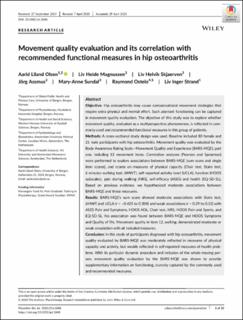| dc.contributor.author | Olsen, Aarid Liland | |
| dc.contributor.author | Magnussen, Liv Heide | |
| dc.contributor.author | Skjærven, Liv Karin Helvik | |
| dc.contributor.author | Assmus, Jörg | |
| dc.contributor.author | Sundal, Mary Anne | |
| dc.contributor.author | Ostelo, Raymond W. | |
| dc.contributor.author | Strand, Liv Inger | |
| dc.date.accessioned | 2020-12-08T13:22:57Z | |
| dc.date.available | 2020-12-08T13:22:57Z | |
| dc.date.created | 2020-10-20T15:27:32Z | |
| dc.date.issued | 2020 | |
| dc.identifier.citation | Olsen, A. L., Magnussen, L. H., Skjaerven, L. H., Assmus, J., Sundal, M.-A., Ostelo, R., & Strand, L. I. (2020). Movement quality evaluation and its correlation with recommended functional measures in hip osteoarthritis. Physiotherapy Research International, 25(4). | en_US |
| dc.identifier.issn | 1358-2267 | |
| dc.identifier.uri | https://hdl.handle.net/11250/2712429 | |
| dc.description.abstract | Hip osteoarthritis may cause compensational movement strategies that require extra physical and mental effort. Such aberrant functioning can be captured in movement quality evaluation. The objective of this study was to explore whether movement quality, evaluated as a multiperspective phenomenon, is reflected in commonly used and recommended functional measures in this group of patients.
Methods
A cross‐sectional study design was used. Baseline included 80 female and 21 male participants with hip osteoarthritis. Movement quality was evaluated by the Body Awareness Rating Scale—Movement Quality and Experience (BARS‐MQE), part one, including 12 movement items. Correlation analyses (Pearson and Spearman) were performed to explore associations between BARS‐MQE (sum score and single item scores), and scores on measures of physical capacity (Chair test, Stairs test, 6 minutes walking test; 6MWT), self‐reported activity level (UCLA), function (HOOS subscales), pain during walking (NRS), self‐efficacy (ASES) and health (EQ‐5D‐5L). Based on previous evidence, we hypothesized moderate associations between BARS‐MQE and these measures.
Results
BARS‐MQE's sum score showed moderate associations with Stairs test, 6MWT and UCLA (r = −0.425 to 0.304) and weak associations (r = 0.29 to 0.12) with ASES Pain and Symptoms, HOOS ADL, Chair test, NRS, HOOS Pain and Sports, and EQ‐5D‐5L. No association was found between BARS‐MQE and HOOS Symptoms and Quality of life. Movement quality in item 12, walking, demonstrated moderate or weak association with all included measures.
Conclusion
In this study of participants diagnosed with hip osteoarthritis, movement quality evaluated by BARS‐MQE was moderately reflected in measures of physical capacity and activity, but weakly reflected in self‐reported measures of health problems. With its particular dynamic procedure and inclusion of the whole moving person, movement quality evaluation by the BARS‐MQE was shown to provide supplementary information on functioning, scarcely captured by the commonly used and recommended measures. | en_US |
| dc.language.iso | eng | en_US |
| dc.publisher | Wiley | en_US |
| dc.rights | Navngivelse 4.0 Internasjonal | * |
| dc.rights.uri | http://creativecommons.org/licenses/by/4.0/deed.no | * |
| dc.title | Movement quality evaluation and its correlation with recommended functional measures in hip osteoarthritis | en_US |
| dc.type | Peer reviewed | en_US |
| dc.type | Journal article | en_US |
| dc.description.version | publishedVersion | en_US |
| dc.rights.holder | © 2020 The Authors | en_US |
| dc.subject.nsi | VDP::Medisinske Fag: 700::Helsefag: 800::Fysioterapi: 807 | en_US |
| dc.source.pagenumber | 1-10 | en_US |
| dc.source.volume | 25 | en_US |
| dc.source.journal | Physiotherapy Research International | en_US |
| dc.source.issue | 4 | en_US |
| dc.identifier.doi | 10.1002/pri.1848 | |
| dc.identifier.cristin | 1840959 | |
| dc.source.articlenumber | e1848 | en_US |
| cristin.ispublished | true | |
| cristin.fulltext | original | |
| cristin.qualitycode | 2 | |

